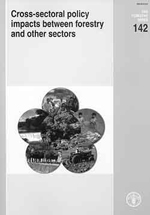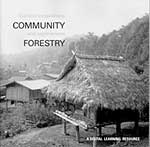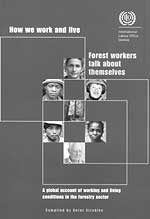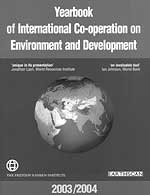

Cross-sectoral policy impacts between forestry and other sectors. 2003. FAO Forestry Paper No. 142. Rome, FAO. ISBN 92-5-104937-8.
 Integration of forestry with other sectors, particularly agriculture, in policy development is essential to end the isolation of forestry from mainstream development initiatives, and policies in other sectors play an essential part in sustainable forest management. In recent years, FAO's member countries, through the Committee on Forestry (COFO), have emphasized the importance of cross-sectoral linkages and have requested that FAO assist countries in strengthening these linkages and in promoting information exchange among sectors. This publication was developed to help policy-makers integrate the concerns of other sectors in forestry, and to pave the way for better consideration of forestry issues by other sectors.
Integration of forestry with other sectors, particularly agriculture, in policy development is essential to end the isolation of forestry from mainstream development initiatives, and policies in other sectors play an essential part in sustainable forest management. In recent years, FAO's member countries, through the Committee on Forestry (COFO), have emphasized the importance of cross-sectoral linkages and have requested that FAO assist countries in strengthening these linkages and in promoting information exchange among sectors. This publication was developed to help policy-makers integrate the concerns of other sectors in forestry, and to pave the way for better consideration of forestry issues by other sectors.
The book assembles contributions from five authors. The first chapter sets the stage for understanding cross-sectoral policy impacts and discusses the impacts of important trends such as globalization, privatization, participatory processes, and increased and diversified demand for forest goods and services.
Chapter 2 presents case studies from Brazil, Italy, Mali, Mexico, Romania, the United Republic of Tanzania and Thailand to illustrate the diversity of socio-economic and environmental contexts in which policies are made and applied.
Chapter 3 indicates instruments and institutional arrangements useful for optimizing policy impacts at different stages of forestry development.
Chapter 4 advocates an integrated system of environmental and economic accounting as a tool for collecting, analysing, monitoring and evaluating information on policy impacts across sectors. Such accounting can demonstrate the economic benefits of forest ecosystems to other sectors, including rural development, agriculture, fisheries, tourism, municipal water supply and others.
The final chapter develops a framework for enhancing coordination of policies in different sectors through better information and knowledge sharing and participation.
The publication will be of interest to policy analysts, policy-makers, forest managers, representatives of non-governmental organizations and other stakeholders, researchers and teachers concerned with cross-sectoral policy issues. It is hoped that this publication will contribute to enhanced coordination in policy formulation and implementation, thus promoting sustainable forest management and people's well-being.
The print edition of Cross-sectoral policy impacts between forestry and other sectors also includes a CD-ROM with the complete country case studies and the proceedings of a technical meeting on the subject held in September 2002.
The publication is available online: www.fao.org/DOCREP/006/Y4653E/Y4653E00.HTM
Community forestry: current innovations and experiences. A digital learning resource. 2003. Bangkok, Thailand, RECOFTC and FAO.
 The move towards community-based forest management to address the linkages between forestry and rural people is one of the most important forest policy developments of the past century. Although the concept of community-based forest management emerged over a quarter of a century ago, many countries are still at an early stage in the process of developing and introducing the appropriate concepts to their situations.
The move towards community-based forest management to address the linkages between forestry and rural people is one of the most important forest policy developments of the past century. Although the concept of community-based forest management emerged over a quarter of a century ago, many countries are still at an early stage in the process of developing and introducing the appropriate concepts to their situations.
This booklet and CD-ROM present the outcomes (together with additional resources) from an international conference held in 2000 to examine ways to smooth the shift from centralized to community-based forest management approaches. The International Conference on Advancing Community Forestry: Innovations and Experiences (Chiang Mai, Thailand, 25 to 28 September 2001) critically examined the spectrum of innovations driving community forestry development and highlighted emerging issues at the local level, with the goal of developing strategies for expanding the scale of its application. The conference, held by the Regional Community Forestry Training Center (RECOFTC), FAO, the International Centre for Research in Agroforestry (now the World Agroforestry Centre) (ICRAF), the World Conservation Union (IUCN) and the Sustainable Management of Resources in the Lower Mekong Basin Project (Germany), focused particularly on the crucial linkages among governance, capacity building and local innovations in community forest management.
This package presents the conference materials in a form designed to be more comprehensive and useful than the usual conference proceedings. The interactive CD-ROM is organized by subject, as follows:
• local innovations: collaborative management agreements, community forestry management practices, community-based forest enterprises;
• capacity building and networking: community forestry education and training, networking and information management;
• forest governance: policy development, forest sector reform.
For each topic, the CD-ROM provides reports and summaries from the relevant conference sessions, together with many supplementary materials. The interactive format allows users to explore for themselves the variety of ideas discussed at the conference.
The booklet contains an overview of the conference, as well as a reflection paper on the current state of community forestry.
How we work and live. Forest workers talk about themselves. A global account of working and living conditions in the forestry sector. B. Strehlke. 2003. Sectoral Activities Programme Working Paper No. 207. Geneva, Switzerland, International Labour Office (ILO). ISBN 92-2-114390-2.
 Sustainable forest management depends on qualified, motivated workers and technicians. Working and living conditions and job benefits must be attractive to build up and retain an efficient workforce. Yet forestry work is often characterized by heavy workloads, safety risks and low pay. An important step towards improving the conditions of forest workers is to find out who these forest workers are and what are their problems, concerns and frustrations.
Sustainable forest management depends on qualified, motivated workers and technicians. Working and living conditions and job benefits must be attractive to build up and retain an efficient workforce. Yet forestry work is often characterized by heavy workloads, safety risks and low pay. An important step towards improving the conditions of forest workers is to find out who these forest workers are and what are their problems, concerns and frustrations.
How we work and live tells the stories of 55 forest workers from around the world. The collection captures the diversity of situations spanning different climates, cultures, national economies, genders and ages. The youngest worker is a 25-year old Brazilian and the oldest is a Swede in his nineties. Manual work, mechanized work and the whole range of forest activities are represented. Collected over a period of almost two years, these stories reflect, on a global scale, what forestry work is like at the dawn of the twenty-first century. Stories from retired workers reveal how forest work has evolved over many decades.
Though diverse, these life stories add up to a general picture with a number of common themes.
• Labour turnover in forestry is increasing and stability of employment decreasing, as the pattern of forest work being passed on from one generation to the next is disappearing.
• Highly specialized work, requiring considerable skills, is carried out side by side with simple manual jobs.
• Contract work is replacing direct employment.
• Differences in remuneration are large.
• Considerable occupational risks (accidents and diseases) persist.
• Since workplaces tend to be isolated from human settlements, most forest workers live in camps or commute over long distances.
• Prospects for advancement to responsible positions differ between industrialized countries, where education and specialized training are major factors, and developing countries, where experience weighs more heavily.
• Women often perform heavy work but suffer wage discrimination.
• Forest work is often attractive to migrants.
• Trade unions and certification processes can improve working and living conditions.
These stories should be read by those interested in forestry, those involved in forest management, foresters and forestry students. Most importantly, they should be read by those in a position to improve working and living conditions such as forest owners, employers, worker organizations and government organizations.
The publication is also available online: www.ilo.org/public/english/dialogue/sector/papers/forestry/wp207.pdf
Fast-wood forestry - myths and realities. C. Cossalter and C. Pye-Smith. 2003. Bogor, Indonesia, Center for International Forestry Research (CIFOR). ISBN 979-3361-09-3.
 Fast-wood plantations are intensively managed commercial plantations of a single species, typically eucalypts, poplars, pines and acacias. They produce industrial roundwood at high growth rates and are harvested in less than 20 years. First planted on a large scale in Brazil more than 30 years ago, such plantations now cover vast areas in many countries such as Chile, Indonesia, Portugal and Thailand. Currently there are an estimated 10 million hectares of fast-wood plantations worldwide, and an additional million hectares of land are likely to be converted each year. Given the rapidly rising demand for paper and other wood products, the increase in fast-growing plantations is likely to continue for some time.
Fast-wood plantations are intensively managed commercial plantations of a single species, typically eucalypts, poplars, pines and acacias. They produce industrial roundwood at high growth rates and are harvested in less than 20 years. First planted on a large scale in Brazil more than 30 years ago, such plantations now cover vast areas in many countries such as Chile, Indonesia, Portugal and Thailand. Currently there are an estimated 10 million hectares of fast-wood plantations worldwide, and an additional million hectares of land are likely to be converted each year. Given the rapidly rising demand for paper and other wood products, the increase in fast-growing plantations is likely to continue for some time.
While many have commended fast-wood plantations for creating employment, providing economic growth and taking pressure off natural forests, many others have argued that such plantations destroy the environment and displace small farmers. Fast-wood forestry - myths and realities provides a comprehensive analysis of the arguments for and against fast-wood plantations.
The publication explores in detail the environmental impacts of the industry, in particular its impacts on biodiversity, water resources and soil fertility. Concerns about the spread of pests and diseases in single-species tree plantations and possible future problems resulting from the use of genetically modified tree crops are also examined. Claims that fast-wood forestry provides rural communities with valuable social benefits, such as jobs, infrastructure and income, are analysed from all perspectives. The publication also assesses the advantages and disadvantages of the subsidies and incentives used by governments and international agencies to encourage the industry. In the final chapter, the authors present a series of recommendations for the fast-wood industry to help improve its environmental and social performance.
After considering both sides of the argument, the authors conclude that environmentalists have frequently exaggerated the negative impacts of fast-wood plantations, while plantation companies have generally underestimated the damage that fast-wood forestry inflicts on both the environment and local communities. The book's message is that fast-wood forestry, when poorly planned and executed, can create great problems; but that when well planned and managed, it can deliver not just large quantities of wood, but also a range of social and environmental benefits. Wherever implemented, it requires a holistic approach addressing site-specific issues.
This publication is also available online: www.cifor.cgiar.org/publications/pdf_files/Books/ForestPerspective.pdf
Can law save the forest? Lessons from Finland and Brazil. S.R. Hirakuri. 2003. CIFOR Forest Law Enforcement Governance and Trade Series. Bogor, Indonesia, Center for International Forestry Research (CIFOR). ISBN 979-3361-02-06.
 Unsustainable forestry activities can often be combated through legislation - but the effectiveness of legislation depends to great measure on monitoring and strict enforcement. In many countries, low compliance with existing forest management laws, rather than a lack of laws, is often a leading cause of unsustainable forestry.
Unsustainable forestry activities can often be combated through legislation - but the effectiveness of legislation depends to great measure on monitoring and strict enforcement. In many countries, low compliance with existing forest management laws, rather than a lack of laws, is often a leading cause of unsustainable forestry.
Indeed in Brazil, as in many other tropical forested countries, it is implementation, rather than policy, that is the problem. This study compares the experiences of Brazil, where law compliance is low, with Finland, where compliance is high. It aims to identify and highlight those variables that could be influenced or better implemented in tropical forest countries.
The book first examines compliance of both timber companies and forest landowners to environmental and forestry laws and regulations in Brazil. The author notes that in Brazil, logging practices are highly regulated, but legal, administrative and financial requirements, e.g. for pertaining logging permits, deter compliance with laws intended to protect the forest. Other factors contributing to low compliance include institutional and financial problems in carrying out enforcement and legal deficiencies in imposing effective penalties.
The publication next provides a case study of the Finnish forest law enforcement system as an exemplary model. It analyses the legal framework of forestry regulation in Finland, and describes the enforcement approach strongly based on educating forest owners about legal requirements and good forest practices, rather than on punishment (a “consensus-oriented” approach). The author emphasizes Finland's market-oriented approach to forest policy, including the use of subsidies and encouragement of certification, and notes the beneficial impacts of this market-oriented approach on compliance with forest law.
The final chapter provides a comparative analysis of the two country case studies, with reference to other Latin American countries. The author acknowledges that the conditions under which forestry is practised differ greatly between Brazil and Finland, but advocates a blend of regulatory, market-oriented and consensus-oriented approaches as a general prescription for effective forest law enforcement.
This publication is also available online: www.cifor.cgiar.org/publications/pdf_files/Books/Law.pdf
Yearbook of International Co-operation on Environment and Development 2003/2004. O.S. Stokke and Ø.B. Thommessen, eds. 2003. London, UK, Earthscan Publications. 11th ed. ISBN 1-84407-030-1 (hardcover); 1-84407-031-X (paperback).
 Compiled by the Fridtjof Nansen Institute in Norway, the Yearbook of International Co-operation on Environment and Development assesses the achievements and shortcomings of international cooperation and describes international positions on specific environment and development problems, the main obstacles to effective international solutions and proposals for how to overcome them.
Compiled by the Fridtjof Nansen Institute in Norway, the Yearbook of International Co-operation on Environment and Development assesses the achievements and shortcomings of international cooperation and describes international positions on specific environment and development problems, the main obstacles to effective international solutions and proposals for how to overcome them.
In this eleventh edition, the “Current issues and key themes” section focuses on:
• transnational multistakeholder partnerships launched at the World Summit on Sustainable Development in 2003;
• the Helsinki Convention on the Protection of the Marine Environment of the Baltic Sea;
• FAO and the management of plant genetic resources;
• the Economic Commission for Europe (ECE) Water Convention;
• the external environment policy of the European Union;
• the Third World Network, a non-governmental organization campaigning for changes in global governance, particularly in regard to international trade.
As always, the bulk of the yearbook is dedicated to describing international agreements on environment and development by presenting extensive information on each instrument: objectives, scope, time and place of establishment, status of participation, affiliated instruments and organizations, secretariat, finance, rules and standards, monitoring and implementation, decision-making bodies, key publications and Web sites. Updated information is also given on intergovernmental organizations, including UN specialized agencies, and international NGOs.
The yearbook is a useful guide for decision-makers in government, international organizations, non-governmental organizations and industry as well as a basic resource for academic institutions, students and libraries serving the public.